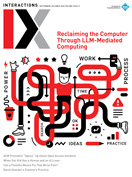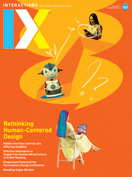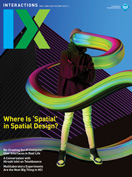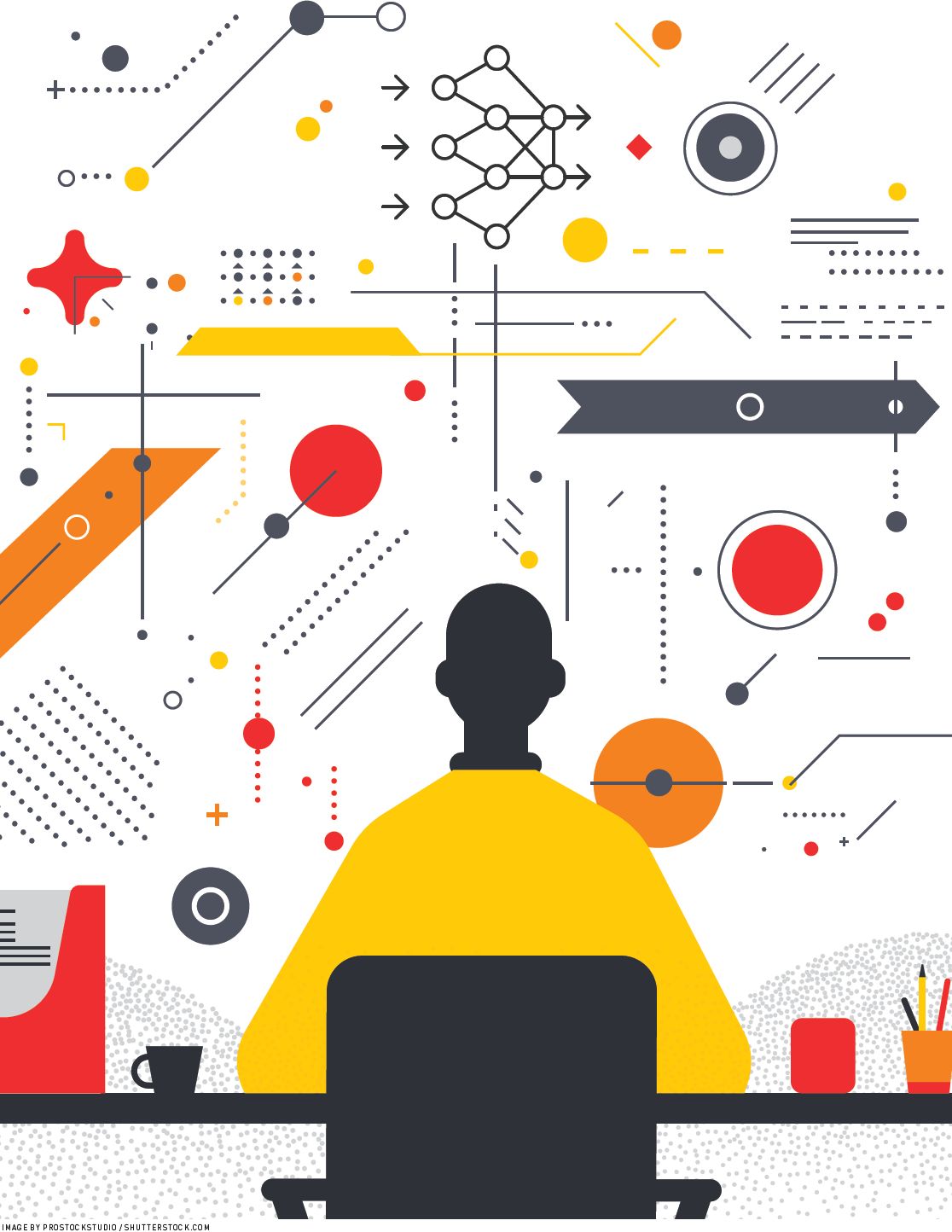Authors:
Mattias Rost
Ever since the desktop metaphor came about at Xerox PARC in the 1970s, we have interacted with computers that present themselves and their capabilities with what they display on-screen. Digital interaction has been organized around applications: isolated silos of functionality that users must manually operate, switch between, and coordinate. Computer capabilities have manifested in features within applications. This has made it easy for humans to operate the machine: The capabilities are easy to spot and fix, allowing them to be learned.
This application-centered model, however, locks the computer's potential behind narrow interfaces. The computer's potential is greater than what is implemented by programmers in the moment. While the computer can be reconfigured in use—through the choice of applications, flexibility of layouts, and enabling of features—its computational affordances are fixed at the time of use. Developers have the flexibility in instructing the computer according to its full capabilities, but once the application is written those capabilities risk being cemented.
→ LLMs enable a reconceptualization of computing, making capabilities emerge dynamically in response to human intent.
→ The computer becomes a relational, dialogic collaborator rather than a representational tool with predefined functions.
→ LLM-mediated computing shifts from the spatial, pre-structured desktop metaphor to a temporal, relational metaphor of reflective conversation.
Yet as large language models begin to understand, interpret, and flexibly act upon human intentions, a different future becomes imaginable. LLMs are increasingly capable of producing the instructions that enable the computer to perform any operation following human intent. In combination with an LLM, the computer has the opportunity to have its capabilities unlocked from the fixed set of application instructions. The interaction with computers thereby changes, a new paradigm emerges, and the need for a new interaction metaphor emerges.
I propose a shift toward LLM-mediated computing: a paradigm where interaction is guided not by navigating tools but by expressing and sustaining one's ongoing intentionality. In this model, the computer, mediated by an LLM, becomes a co-constructive participant in human activity, dynamically adapting its behavior to support what the user is trying to do. Rather than being operated like a toolbox, the computer collaborates, orchestrates, and engages.
This shift is not merely technical. Grounded in postphenomenology, the phenomenology of intentionality, and traditions of slow technology, it represents a rethinking of the computer's role in human life. It offers the possibility of computing that is not only more powerful but also more aligned with human activity.
What if, instead of launching Word, checking Gmail, and opening Chrome, we could remain within the flow of writing, communicating, and exploring? What if computing responded to our activity, rather than requiring us to reshape our intentions to fit its tools? This article outlines a conceptual framework for that future and calls for us to reclaim the computer as a companion in thought, expression, and being-in-the-world.
 The Problem with Application-Centric Computing
The Problem with Application-Centric Computing
The desktop metaphor allows for a conceptual model in which software applications mediate access to the computer's capabilities. We use email clients to send messages, word processors to write documents, browsers to explore the Web. These applications are designed to expose selected capabilities of the computer. But rarely do we interact with the computer itself. Instead, our use of computing is channeled through applications, which makes computers accessible but also restricts their potential.
LLM-mediated computing proposes a shift: from AI as a feature of tools to the LLM as a mediator of human intentionality across contexts. This reframes computing not as automation but as collaborative sense-making.
This mediation fragments human intentionality. In phenomenological terms, intentionality refers to the directedness of consciousness toward a project, object, or activity. Sustained engagement depends on maintaining a continuous relation to what we are doing. But application-centered computing breaks activities into discrete software environments, each requiring a shift in mental framing and attention. When users have to manually switch between tools—for example, moving from email to calendar to document—the continuity of intentional experience is disrupted. While the email client presents the computer as an email-capable machine, the calendar offers other affordances made readily available for calendar-related tasks that have no relevance to original intent.
Using a computer, therefore, becomes more about managing tools than staying with the task at hand. When deeply engaged in writing, for instance, the word processor and keyboard may become ready at hand: They recede from awareness and allow thought to flow. But a simple shift to an email client can break that absorption, bringing the interface back into view and pulling the user out of the activity.
Cognitive psychology has long shown that task-switching imposes hidden mental costs. Each switch requires people to suppress previous contexts, activate new ones, and manage overlapping intentions. The phenomenon of "attention residue" describes how a part of the mind stays caught in the previous task, even after we've technically moved on [1]. In application-centered computing, where switching is frequent and often encouraged, users accumulate layers of unresolved mental fragments. The result is fatigue, shallow engagement, and a diminished sense of digital well-being.
This fragmentation is visible even in simple tasks. Take spreadsheets: Computers are naturally adept at manipulating numbers, yet using a tool like Excel often requires users to encode operations step by step or through abstract formulas. Even a basic request, such as doubling a column of values, must be manually specified, despite the computer's ability to execute it instantly. The application structures interaction around manual steps, limiting access to the computer's deeper capabilities.
This pattern is not limited to spreadsheets. Across the digital environment, applications present curated slices of computational power, often optimized for surface-level tasks, while obscuring more flexible possibilities. Photo editors support basic adjustments but restrict transformation. Browsers support search but limit more-complex forms of data collection or analysis. Interaction is structured around predefined workflows, not open-ended capability.
In short, application-centered computing imposes invisible but profound limitations. It fragments intentionality, increases mental effort, and obscures the computer's potential as a medium for flexible, sustained, human-directed activity.
 The Opportunity of LLM-Mediated Computing
The Opportunity of LLM-Mediated Computing
With the introduction of tools such as ChatGPT, millions of users now interact with LLMs daily: asking questions, generating text, summarizing information, and, increasingly, writing code. What began as a productivity boost for programmers has evolved into something more transformative. LLMs can now produce complex software applications directly from natural language prompts. Recent models rank in the top percentile of competitive coding benchmarks, and services such as Lovable and Bolt offer end-to-end software development without requiring users to write any code. These developments signal a shift not just in what computers can do but in who can instruct them, and how.
At its core, code is a set of instructions for the computer: It activates capabilities, defines behavior, and unlocks the general-purpose power of the machine. As LLMs become increasingly capable of generating code from natural language, they serve as translators of human intentionality into computational action. This makes imagining a new form of interaction possible—one where users no longer operate applications but instead express what they are trying to do, and the computer configures itself accordingly.
Instead of opening an email client, the user might say, "I need to reply to this message," and a writing space would appear. Instead of working in spreadsheets, we might work with the numbers directly, letting the computer deal with formulas and computation where it is needed. Input fields, sliders, and visualizations might still be offered, but only as needed, supporting the activity rather than defining it.
This reconfigures the computer not as a set of applications but as a general-purpose machine capable of participating directly in human activity. The LLM becomes a mediator: interpreting user intent, generating instructions, and orchestrating the computer's capabilities in response. It frees the user from the constraints of application boundaries and the computer from waiting for developers to expose its functionality through fixed interfaces. Interaction becomes adaptive, contextual, and aligned with the user's unfolding intentionality.
The von Neumann architecture laid the foundation for software by introducing a clear separation between hardware and instructions. Prior to this, altering the behavior of a computer required physically rewiring circuits or changing plugboard configurations. With the advent of stored-program computers, operations could be changed by loading new software into memory, making the computer functionally flexible without modifying its hardware. LLMs mark a similar transition: Software itself no longer needs to be statically defined in advance. Instead, LLMs can generate, adapt, and reconfigure software behavior on demand. Just as software once liberated computing from hardware constraints, LLMs now render software malleable, opening up a new mode of dynamic, instruction-based computing.
Importantly, we are not proposing that the LLM is the computer. Rather, the LLM generates the instructions that the computer executes. It serves as an interpretive layer that translates human expressions of intention into machine-level instructions. In this sense, the LLM acts as a mediator between human and computer, not as a replacement for either. What this requires is a runtime environment where those generated instructions can be executed reliably. While the LLM can compose the instructions, such an execution layer is still largely missing in contemporary computing.
Recent work in HCI has explored intelligent assistants, natural language interfaces, and autonomous agents that can take actions on behalf of users. However, these systems often retain the structure of application-centered computing, embedding AI within existing app boundaries or treating tasks as discrete commands. In contrast, LLM-mediated computing proposes a deeper shift: from AI as a feature of tools to the LLM as a mediator of human intentionality across contexts. This reframes computing not as automation but as collaborative sense-making.
While tools such as GitHub Copilot, Microsoft's AI-integrated Office, and autonomous agents such as AutoGPT point toward more adaptive computing, they often remain confined within discrete applications. These systems augment specific tasks but rarely challenge the broader architecture of interaction. LLM-mediated computing instead invites a rethinking of the computing substrate itself. It is not a collection of apps enhanced by AI but rather a system responsive to evolving human context and sustained intentionality.
The shift from application-centered to LLM-mediated computing is not merely technical. It challenges how we relate to computing as a whole: how capabilities are presented to us, how intentionality is supported, and how digital environments mediate our experiences. To understand the significance of this shift, we turn to the philosophy of technology, and, in particular, to postphenomenology, the phenomenology of intentionality, and the tradition of slow technology.
Postphenomenology: Mediation and human-technology-world relations. Postphenomenology offers a powerful lens to examine technology not as a neutral tool, but as a mediator of experience, as articulated by Don Ihde [2] and Peter-Paul Verbeek [3]. Technologies structure how we perceive, act, and relate to the world. These mediations come in various forms (embodied, hermeneutic, alterity, background). They are often multistable—a single technology can support different kinds of relations depending on the situation.
A car offers a vivid example of technological mediation. While you are driving, the steering wheel, pedals, and mirrors typically recede into the background of awareness, becoming extensions of the body. You are not focused on the machine, but on the destination—driving to work, listening to the radio, navigating traffic. The car becomes an embodied means of engaging with the world. Yet it also reshapes that world: It structures movement through roads, enforces direction through traffic laws, and makes certain spaces accessible while rendering others distant. But when a flashing warning light appears on the dashboard, this seamless relation is broken. Attention shifts away from the journey and toward the car as a system. The technology becomes present—not as a vehicle for action, but as an object of concern. The fracture reveals the car as an active mediator that both enables and constrains experience.
Viewed through this lens, application-based computing is a particular form of technological mediation. It restricts how the computer's capabilities are made available. Applications act as intermediaries. They mediate not just the interface but the entire range of computational possibility. What the user can do is limited to what the application was designed to support. While this can enable ease of use for specific tasks, it also creates a constrained, fragmented experience. The operating system itself, from the user's perspective, becomes just another application: a preconfigured set of options for managing the rest.
LLM-mediated computing as co-constitution in use. With LLMs, this model begins to shift. Instead of selecting from fixed menus or navigating between prebuilt interfaces, users can express what they are attending to, reflecting, exploring, or trying to carry forward. The computer, mediated by the LLM, responds not with pre-scripted steps but by dynamically generating instructions and assembling capabilities.
This introduces a radically different form of mediation: one that is co-constituted through use. The computer's capabilities are no longer predefined by a developer; they're reconfigured in response to human intentionality as it unfolds. What the computer is in any given moment (an editor, a researcher, a calculator, a synthesizer) is shaped by the user's orientation toward the activity and the ongoing collaboration that emerges in interaction.
This return to general-purpose computing, now mediated through intelligent interpretation, echoes early visions of the computer as a "bicycle for the mind." But now the pedaling happens through dialogue. The user no longer has to convert intent into commands. The LLM does the translation, enabling deeper focus and broader expression without having to manage the machinery.
Phenomenology of intentionality: Continuity of experience. Phenomenology emphasizes that experience is always structured by intentionality. Consciousness is not passive but always directed toward something. In application-centered computing, this directedness is repeatedly fractured by the need to switch tools, reorient attention, and adapt to disjointed interfaces that, as Lucy Suchman [4] critiqued, often presume pre-scripted plans rather than supporting situated action.
LLM-mediated computing instead aims to sustain and respond to intentionality as it evolves. When the user remains immersed in a single unfolding activity (reading, composing, comparing, analyzing) the computer continuously adapts to support that engagement. Friction is reduced not by eliminating complexity, but by aligning system response with the coherence of experience.
What results is not merely better usability but a reorientation of interaction around the structure of lived engagement itself.
Slow technology and the ethics of mediation. The idea of slow technology, introduced by Lars Hallnäs and Johan Redström [5], reminds us that interaction does not always have to be efficient. Systems can be designed to support reflection, presence, and care. LLM-mediated computing holds the potential to carry this ethic forward in a new form by placing intentional friction at activity boundaries, encouraging mindful transitions, and letting systems pause, wait, and respond to human rhythms.
Instead of hurried hopping between apps, interaction becomes a space for depth. The system adapts to the pace and texture of the user's engagement, offering support when needed and retreating when not. It creates conditions for a more humane digital environment that values reflection as much as resolution.
A relational ontology of computing. Ultimately, LLM-mediated computing invites us to rethink the ontology of computing itself. No longer a set of fixed tools, the computer becomes a relational system that is co-constructing activity in response to human intent. It is no longer simply a programmable device, but a mediating presence that participates in the unfolding of action and meaning.
This shift from operation to relation repositions computing within a broader ethical and experiential frame. It places human being-in-the-world at the center of interaction design. To begin imagining what this might look like in practice, we turn to a small, situated moment—an interaction shaped not by tools or tasks, but by presence, intention, and unfolding collaboration.
To make this vision more tangible, imagine an interaction that's not defined by apps or tools but by unfolding activity where the computer participates in what we are doing, adapts to our gestures, and offers affordances in context. Rather than waiting for commands or requiring navigation between fixed functions, the system responds to what emerges. The following vignette illustrates such a moment. It's not a utopian dream; rather, it's a sketch of what becomes possible when computing is rethought as material, dialogic, and mediated through intent.
At home, someone is sketching a garden plan on a tablet computer. As they draw rough shapes for paths and planting areas, the computer begins to respond. It does not interrupt but adapts quietly in the margins. It suggests companion plants based on sunlight, draws a soft overlay for soil zones, and highlights drainage paths. A slider appears below the sketch: season. The user drags it, watching as the garden transforms through spring, summer, and fall. Plants grow and bloom, shadows shift, rainfall patterns animate. They move a pathway slightly to the left; the system adjusts slope gradients and updates foot traffic wear. "What happens if I put a small pond here?" they ask, sketching a circle. Ripples appear, and new options slide into view: aquatic plants, safety guidelines, cost estimates.
Below the sketch, they begin to write: "Ben, how about this for our garden project?" The system interprets the intent to share and adapts accordingly. A soft prompt appears: "Share with Ben?" offering options to send an interactive version, invite him to coedit, or schedule a time to review together. These options emerge within the same space, without navigating away, without opening new tools. The system remains in the flow, shaping itself around the conversation. There is no shift from drawing to messaging, from app to app. Instead, the act of sharing becomes part of the same unfolding interaction: continuous, situated, and mediated through intent. The interaction unfolds like sculpting with a living material: responsive, contextual, and relational.
While this vignette takes place on a tablet at home, this vision is not limited to desktop computing. The same logic applies to smartphones, tablets, and other app-based devices. In fact, it may be precisely in these contexts, where distraction, overuse, and fragmented attention are most acute, that LLM-mediated computing offers the greatest promise. By supporting coherence of experience and enabling ongoing intentionality to remain intact, this paradigm shift opens the door to more grounded, reflective, and humane digital life.
 From Desktop to Conversation: A New Interaction Metaphor
From Desktop to Conversation: A New Interaction Metaphor
This shift calls for a new interaction metaphor. The desktop metaphor makes computing representational: Icons, menus, and applications signify what the computer can do. By clicking an icon or pressing a button, a predefined function is executed. In contrast, LLM-mediated computing is relational. What the computer can do is not presented in advance but emerges through interaction. Capabilities are enacted dynamically, and the computer itself is co-constituted through the unfolding relation between human, LLM, and machine.
This interaction is better understood as a conversation. Drawing from conversation analysis and Donald Schön's [6] notion of reflective conversation, we can frame LLM-mediated computing as a dynamic, dialogic engagement. The user expresses intent; the LLM responds; the user reflects and replies. The system "talks back," prompting further reflection and action. Turn-taking becomes a natural unit of analysis. Not just turn by turn but also in side-by-side collaboration and copresence.
In this model, computing shifts from task-focused interaction to reflective and interpretive engagement. While interactive systems have long responded to user input and context, they have not been able to reconfigure themselves in anticipation of intent. As a result, the metaphor of conversation has largely remained confined to chatbots and conversational UIs. But LLM-mediated computing is different. Conversation is not the interface; it is the mode of interaction. It structures engagement through dialogue but is not limited to linguistic exchange. Where the desktop metaphor offers a spatial and representational schema for communicating capability, the conversation metaphor introduces a temporal logic—affordances emerge in sequence, not in space.
Through this metaphor, computing begins with a topic or intention and evolves as both human and machine contribute. They co-constitute the conversation, and through it the computer as it comes into being in use. The LLM surfaces latent capabilities; the user responds through reflection and situated action.
 Toward a More Humane Digital Environment
Toward a More Humane Digital Environment
As we wake up and check our phones, we are drawn into a familiar rhythm: the weather, a friend's message, a cat video, a calendar alert. Our attention fragments before we have even left bed.
This is not an unusual beginning to the day. Many people now express a desire to reclaim their time, their focus, and their sense of agency in relation to their devices. Some speak of harm from excessive screen use. Others feel their attention has been co-opted, scattered across platforms, notifications, and perpetual switching. What often goes unnamed is that this experience is not inevitable. It is designed, and it is deeply tied to the application-centered paradigm of computing.
More than two decades ago, Hallnäs and Redström proposed slow technology, envisioning interactive systems designed for reflection, presence, and care, not for speed. While prescient, this vision has not been fully realized. Computing remains structured around efficiency—operating systems that streamline switching, apps that maximize engagement, and platforms that benefit from keeping users suspended in use.
LLM-mediated computing offers a chance to rethink this logic. If systems can now interpret and respond to human intentions in context, we are no longer required to orchestrate activity through constant app switching. Instead, interaction can remain within the arc of what we are doing. Efficiency is redefined not as acceleration, but as continuity. As systems adapt to our evolving focus, they can enable deeper engagement and more grounded use.
This is not just a technical development. It is a philosophical and ethical one. If LLMs can now instruct the computer to do anything the computer can do, then how we choose to shape that power becomes a question of design, responsibility, and care. What kind of digital environments do we want to inhabit? What kinds of relationships should we cultivate between ourselves and our machines? And what does this mean for computer literacy in a world where instruction is increasingly conversational?
To answer these questions, we need new imaginaries, new practices, and new commitments. We need to move beyond applications, beyond the desktop metaphor, and beyond interaction as control. We need to move toward computing as dialogue, as companionship, and as shared activity.
The material is here. The opportunity is real. What remains is to take it seriously and begin the work of reclaiming the computer, not as a toolbox of apps but as a companion in thought, expression, and activity. To reclaim the computer is to reclaim our time, our focus, and our way of being-in-the-world with technology.
I would like to thank Oskar Lindwall and Jonas Ivarsson for their insightful conversations and for their comments on early versions of this piece.
1. Leroy, S. Why is it so hard to do my work? The challenge of attention residue when switching between work tasks. Organizational Behavior and Human Decision Processes 109, 2 (2019), 168–181.
2. Ihde, D. Technology and the Lifeworld: From Garden to Earth. Indiana University Press, 1990.
3. Verbeek, P.-P. What Things Do: Philosophical Reflections on Technology, Agency, and Design. Penn State University Press, 2005.
4. Suchman, L. A. Plans and Situated Actions: The Problem of Human-Machine Communication. Cambridge University Press, 1987.
5. Hallnäs, L. and Redström, J. Slow technology—Designing for reflection. Personal and Ubiquitous Computing 5, 3 (2001), 201–212.
6. Schön, D.A. The Reflective Practitioner: How Professionals Think in Action. Basic Books, 1983.
Mattias Rost is an associate professor in interaction design in the Department of Applied Information Technology at the University of Gothenburg. His interest lies in designing, building, and studying use of everyday technology, with a particular focus on digital well-being and the emerging affordances of artificial intelligence. [email protected]
 This work is licensed under Creative Commons Attribution International 4.0.
This work is licensed under Creative Commons Attribution International 4.0.
The Digital Library is published by the Association for Computing Machinery. Copyright © 2025 ACM, Inc.







Post Comment
No Comments Found